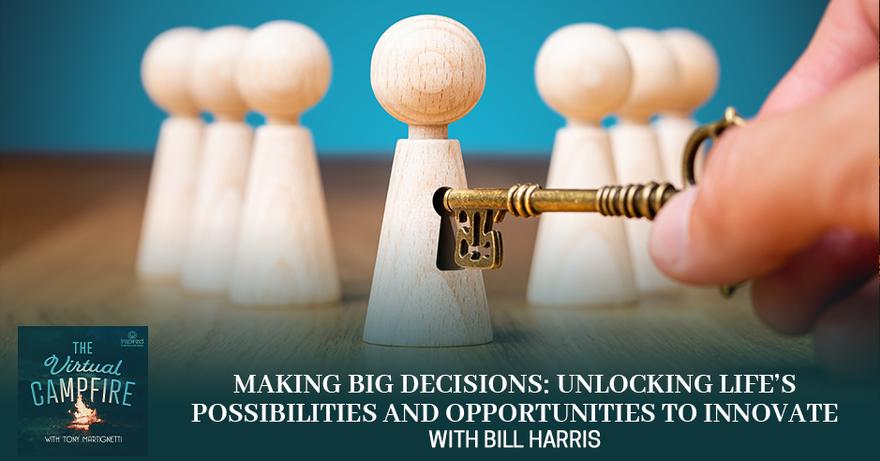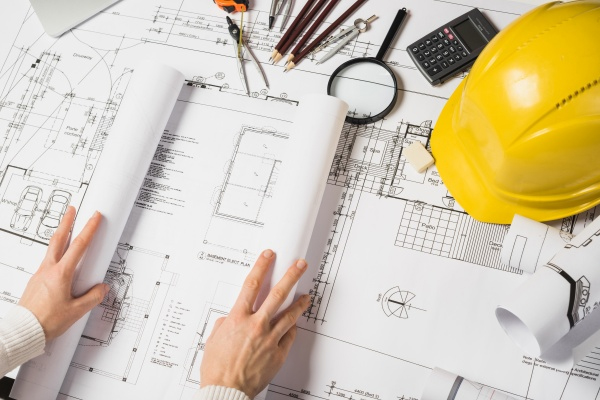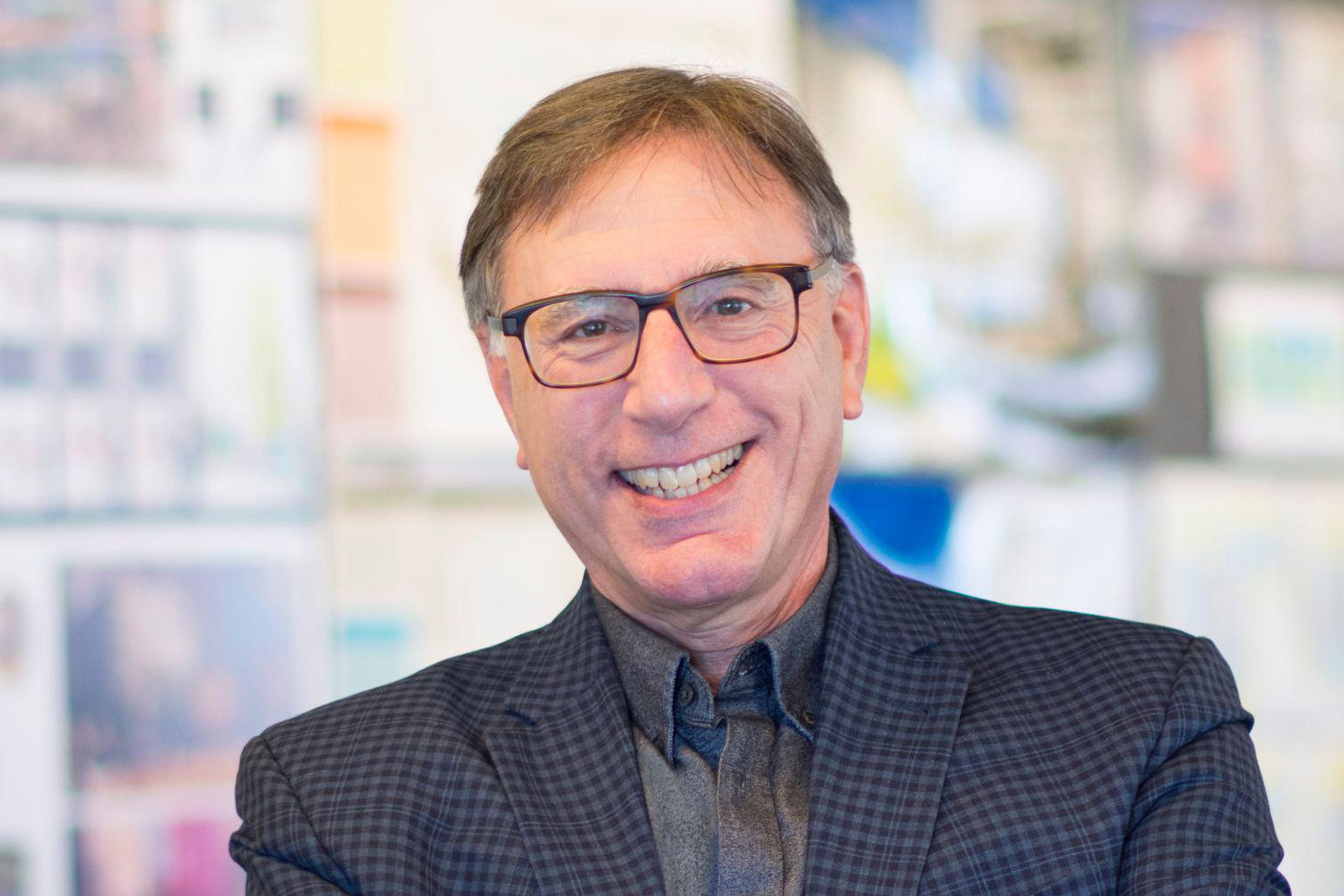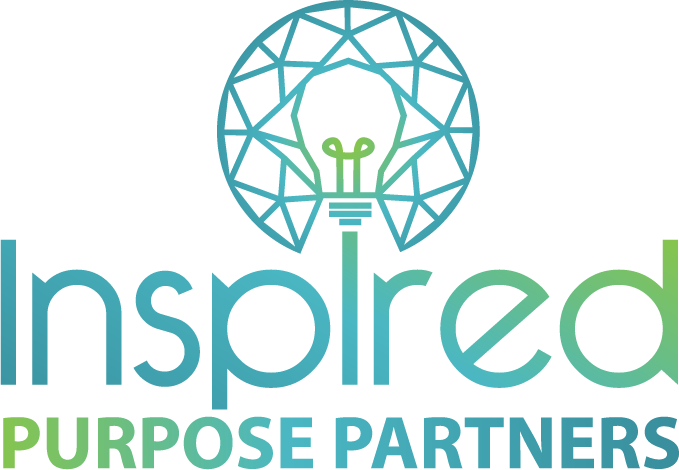Making Big Decisions: Unlocking Life’s Possibilities And Opportunities To Innovate With Bill Harris

Letting go of everything in order to start a business can be a scary leap most people aren’t going to take. But letting go of that business that you’ve just created to do something else can be twice as scary. These are two of the biggest decisions Bill Harris has had to make in his journey. Joining Tony Martignetti on the show, this architect walks us through the several flashpoints in his career: from discovering his love for architecture, to starting his own architectural firm, to being introduced to the power of biotechnology, and to being recruited into one of the world’s leading architectural design firms, Perkins & Will. Each big shift in Bill’s journey allowed him to unlock more innovation and possibilities. Get inspired by Bill’s story and learn how to find your niche – one that you would gladly give everything up to pursue!
---
Listen to the podcast here:
Making Big Decisions: Unlocking Life’s Possibilities And Opportunities To Innovate With Bill Harris
It is my honor to introduce you to my guest, Bill Harris. He started his own architectural firm in 1989, the same year he and his wife bought a home and had their first child. From two incomes and apartment living to a mortgage and no fixed income, Bill grew his business out of his attic and is now the Managing Director of the New York studio of , one of the world's leading architectural design firms. His journey combined the desire to surround himself with bright and adventurous thinkers, a focus on combining and blurring different disciplines and a battle to avoid micromanagement. His motto is, “Make it work, make it inspire.” He lives in both New York and Cambridge. We'll talk more about how that impacts his story. Bill, I want to welcome you to the show.
Thanks, Tony. It's a pleasure to be here and to be working with you in this context. This is the third relationship we've had business-wise. Two different biotech companies and now this.
I've always been taken by your ability to inspire people with your eye on design but also your energy, it's powerful. Bill, I'm thrilled to have you on the show.
It's great to be here. I enjoy talking about my journey and being reminded of the things that were challenges along the way and opportunities. Much of what all of us do in leadership positions is to coach others. Remembering what we went through is critical to shaping our own future and then helping to shape those who follow us.
The challenges make us who we are. That’s the beauty of it. Looking back makes it come to life. As you may or may not know, this is how we do on the show. We talk about your story through flashpoints. These are points in your story that ignited your gifts into the world. There might be one or many. You can start wherever you like. Along the way, we'll pause and see what's showing up.
There were some simple but seminal moments. I grew up in a small town in Northern Vermont. My father was from Vermont. My mother was from Montreal though. She had quite a large family there. I have many cousins. It was a regular event for us to pile into the car and to drive up to Montreal for long weekends. We do that 3, 4 or 5 times a year. Invariably, we would be driving up after dark. If you're familiar with that part of the country, the beautiful green mountains end. That's the border with Canada and then it's flat. You see the glow of the city of Montreal from 50 miles away. As you get closer, the glitter gets brighter. You drive into the city and there are towers and exciting things going on and activity. It established my love of architecture and my excitement about cities, activity and the idea that there's something out there that's awaiting and more exciting.
Make it work. Make it inspire
I often think back to that both as a personal experience family-wise, but also in terms of shaping my appreciation of the city. I love growing up in Vermont. It's terrific. I still go back there. Now, all these years later, to be living in both New York on 5th Avenue and in Cambridge, Massachusetts is a remarkable dream come true. Another part of that story that's relevant to my journey is my mother from Montreal, the big city, my father from the country. My mother was an artist, not a professional one but an artist. She painted. My father was a businessman. What I grew up with was this dual sense just as with you. You have a business mind but an artistic background in history as well.
To combine those two and to be able to see everything almost simultaneously from two sides, from the artistic or visionary or aesthetic and from the business side is your superpower. It's not exclusive to me but it's one of the things that has helped me in my career. It’s to see things from all sides. At the same time, doing that in a way that connects different things. It connects people, business, opportunities, industries, places, food combinations. I love to cook. It infuses an entire perspective on the world. It's the thing that excites me most about what I do. It’s making those connections.
It’s a fun part of the people side of the business, but it's also a fun part of the design side of the business, the growth side and the innovation side. In a way, it is what innovation is. It's seeing connections and opportunities that other people don't see. That's framed my journey and has been pretty consistent in the theme of all of my jobs and how I transitioned from one job to the other. In your introduction, you described where I am now and that I had started my own business.
I did that because I had a vision of something that I wanted to accomplish that I couldn't quite do where I was. It wasn't that it was bad where I was, but I wasn't in alignment. People didn't share my enthusiasm and excitement for opportunity and innovation. Also, one of the things that's a real challenge in architecture is being able to respond to two masters. There's the design muse and then there's the financial driver. We have many architects out there who are starchitects. They create beautiful work but could care less for the client and for the operation. There are architects out there who can deliver super economically but there's no vision.
I believe that you can and should have both. You should be able to do both. When I left my employer at the time in 1989, it was because I wanted to do that. I wanted to accomplish that mission and to move it forward. I didn't see a path there. I made the move. I wasn't intending to start my own business. I was in a holding pattern between jobs because I thought I didn't want the responsibility of starting my own business. I had a friend who was an industrial designer. They were dabbling in architectural work. I love industrial design, graphic design and packaging. I remember going to their company holiday party. They were boasting about some interior design work that they were doing for a retail company.

They were doing other work as well. I thought, “They're getting into my business. I could get into theirs. Maybe I could work with them.” It sounded exciting. We try a project together. It was successful but it led to two surprises. One is at that point, I was doing it on my own freelance. I had left my business, my former employer.Two surprising conclusions, one is that I enjoyed working on my own. The second was that I could do it. It's not that I knew all of the bits and pieces that were required, but the parts that I didn't know happened to be parts that were easily procured through other consultants or people who could support me. The parts that I both enjoyed and was reasonably good were the parts that are harder to obtain from a third-party. That led me to realize that I could maybe make something of going out on my own.
There's so much to unpack with this. It’s powerful to go off on your own. I wanted to get a feel for what was the moment that showed up where you had to make the leap into this new world that you started your own business. You did it and you made it work but there was this element of being in that place of like, “Can I stand to be doing this for the rest of my life with another company?” It comes from this nature of always seeing that you wanted to feel into your own place of design where you wanted to create things.
The initial story that you painted, you painted a story that I visualized around entering Montreal out of darkness and into the light. That was a beautiful way to show the power you have of creating a visualization and taking people on a journey of seeing things through your eyes. That's something that is part of your gift. It's part of that connection that you create between where people are, whether they're coming from a business discipline or art discipline, and then bringing it to the other side to see the other side, to be that bridge. It makes me think about design in general and how people underestimate how much design has an impact on their world in general.
I've been designing R&D lab spaces for several years. For the first fifteen of them, at least the qualification was getting the plumbing right. It was a technical thing. If you had the patience and coordinate all the utilities, you could be a success. There was a moment where things started changing. Clients started pulling me aside and saying, “Design can help us be more collaborative, innovative, creative and successful. We want you to help us figure out how to do that through design.” It was a challenge for both the aesthetics, the environment, the social side of it, as well as the technical side of it because there were fundamental ways in which the spaces and organization of the spaces, labs, offices, support rooms were hindering and slowing down the ability of the scientists to do their work. To come along and be able to influence that in a positive way is a huge opportunity, let alone responsibility.
I know we took two different things and I bundled them into one because I love that you talked about this. This is something that's creating a lot of energy for me here, but I do want you to come back to the thing I said which is bring me back to that moment of should I stay or should I go. Tell me more about that experience of jumping off on your own.
Jumping off is about two things. One is about being pulled by desire and about being pushed by some motivation. I had been with the firm I was at for several years. I had risen and had a title but you get to the point where you say, “Are these the people that I want to be with forever? Do I feel like I can exert the control and influence that I want to exert?” That was an easy thing to realize that I loved the firm and the people, but I knew it was not long-term. It didn't take a lot of effort to figure that out. The effort was what was next, what was going to pull me next. I did have this opportunity to take a pause and say, “I've got this little thing on the side. I can work with these few little things.”
Innovation is about seeing connections and opportunities that other people don’t see.
Doing freelance work as an architect, especially when you're earlier in your career is not an unusual thing to do. I felt like I didn't have to go from job to job. I could fill a gap a little bit in between. It didn't take me too long to realize that I liked the independence and that I thought that I could do it. I started asking everyone for advice, “How do I do this? How do I calculate it?” I went to my accountant at the time. I described where I was and what I wanted to do.
He was the first one who gave me the advice about identifying what it is that I either don't do well or don't want to do. If that's the peripheral support stuff that I can outsource by either hiring consultants or hiring more people, but the key stuff that I like to do is the fundamental, essential stuff, then I should feel empowered and able to do that because I can always buy the support. That worked out well. The other half of it was all of the calculations about how many months could I go and how much work would I need. My wife and I did calculations endlessly. We said, “They're not going to give us the answer.” At a certain point, you're either going to trust it or try it. Try it and fail if you have to but try it, give it a whirl.
That's what happened. I remember going to my wife and saying, “I have to hire somewhere.” She said, “We can't do that. We have to share the money that's coming in?” I said, “No. This is what happens. You get more people working with you and then they generate more money.” That worked out well. She learned that lesson. This all happened at the same time that we've been looking for a couple of years to move from an apartment to a house. That happened right at this moment. My wife got pregnant right at this moment. Everything changed at once in less than twelve months.
We never looked back. My wife did not return to her career but instead started helping me as my business grew. She became the other half of all those skillsets that I didn't have that needed to be supporting me. Fast forward several years, I came to another pivot point. Starting with around the crash of 2008, everything in business dried out. It was slow for architects except for life sciences and biotechnology. At that point, going into 2008, about a third of my practice was in lab design. At that point, I had already hired my first scientist. We had been working with a client who we were doing their labs and they had assigned a lab manager to work with us and be the interface. It turns out that she was a frustrated architect herself and ultimately, came to work for us with the blessing of her company.
All this was happening in that timeframe. As my business was accelerating and we were growing, unfortunately a lot of other architecture firms were laying people off. I was a little tiny shop doing a specialty business that was on no one's radar at the time. Now, everybody wants to design biotechnology spaces because they are the patrons of architects and they care about design. Back then it was about plumbing. It was at that moment where it was changing from plumbing into purpose. It wasn't so popular. I would have had a lot of trouble hiring talent because in 2007, it was a real shortage of architect but because everybody else was laying off, I got my pick of some phenomenal people.

They help grow the business. Come 2010, 2011, we were coming up at the end of our five-year lease on space that was designed for a maximum of twenty people. We had 35 people in there. I was starting to look at new real estate and lease space and realizing that my overhead was going to climb dramatically. Also, I was the only ownership of my firm. Although I had some talented people, I didn't see immediately a clear succession plan. I was prepared to grow the firm and to take that extra leap. About that time, I got a call from Perkins & Will. They had a new Managing Director, Robert Brown, in the Boston studio. I knew Robert. He approached me and said that they saw a future in this life science stuff.
They didn't have it in the Boston office at the time. They had some academic science but not commercial science. He invited me to come in with my whole practice and lead the science team within the Boston studio of Perkins & Will. That did not take a lot of time for me to think about. In the same way that 23 years earlier, I had a vision about what I wanted to do and needed to find a better platform for doing it. Also, at that point, there were the business aspects in terms of lease and overhead and people. I was also at the point where I was interested in taking on larger projects, more interesting and complex projects. Perkins & Will offered the platform to do that. If they had not offered me leadership of the practice, it would have been different because I have too much of an entrepreneurial bug to not have the ability to influence and grow something.
They offered that and I left behind the management. That was a little bit of adjustment. I was no longer the king, but by the same token, I gave up a lot of other responsibilities that I had that were okay to give up. Five years passed, the CEO of Perkins & Will called me up and asked me if I'd be interested in moving back into a management position and running the New York studio. That took me about maybe three quarters of a millisecond to figure out my answer on that one. Every so often I have to laugh and think about what my father would say. My father would have loved to be in New York City. He was a born and bred Vermonter. He never would have done it, but he would have loved it and respected it. You look at the arc of one's life and how things connect and the direction that they go in. It's not a coincidence because one has to be open to these things. You have to see the opportunity. You have to be attuned to them. It is interesting how all these things circle.
One of the things that I'm picking up from this story is it's this underlying current of when people think of, “When is it time for me to transition to that next thing?” It takes courage for someone to know, “It's time for me to move on from this. It's time for me to switch from this to that.” When a founder starts a company and he's able to say, “It's time for me to shift into something different. It's okay for me to take my baby and give it to somebody else as long as I'm given the freedom to operate with the that I hold dear, that the vision that I created for that business is still held to what it was.”
I see a lot of courage in what you've done. Every move you've taken has required courage, but you did it with such ease it almost seemed, but I know that's in hindsight. Every time you've done this, it's unlocked more innovation and possibilities. More things have been unlocked in that journey because you've made the right bets in each step you've taken. Have there been any regrets I should ask in terms of your journey and things that you've done that you're like, “I wish I had done this, hadn’t done that?”
No, because if I made missteps along the way, they formed me for the next corner that I had to turn. There are no regrets in the moves, going out on my own, joining Perkins & Will and going to New York. It's all been exciting. Every promise of opportunity has played itself out. Not that it's all a rosy picture. These are tough jobs to do.
No matter what you consider a weakness in your own performance, there is always room to change and improve.
I wanted to come back to something you talked about because I talk a lot about inspiration. It’s a big part of my life and a big part of trying to find that in other people. How do you keep yourself inspired to keep on doing projects that let you up? You talked about how sometimes architectural jobs they can be functional and not the things that bring people to a new place to incorporate the design that blows people away and makes people feel something. How do you keep yourself on that edge of inspiring? Is it something that's innate or is it something that you feel like you need to connect with something to get there?
It's innate, Tony. We all go through our downtimes and our fatigue times, especially during COVID, it can be challenging. I find that I am a victim of my own pleasures. My own pleasure about making connections, I can't walk away from it and I can't resist it. As it happens, it's the making connections that is fundamental to me getting excited about what I'm doing. Even the projects that tend to be more operational or utilitarian, there's always something one can find to get inspired by within them. I also have a pragmatic side of me which recognizes that not all of my projects are going to be A-plus clients projects. They don't all have to be the first thing that I show in a portfolio of my work because I don't want to be the architect that only does that work.
I wouldn't be good at it. I care too much about people and solving specific problems to turn away from those things. I also have a long view. I've always been concerned about financial stability not only for me, but especially for my employees. I know that you can't do that if you don't have some mix of project types and some bread and butter to go along with the jams and preserves, and also to play the long game. I've been doing this for a long time. I'm getting calls now from clients that I've worked with for 20, 25, 30 years. Let's do this project together. It's a nice place to be. You have to have patience and belief that that's going to happen in order to sustain you along the way.
That's something that is powerful insight right there, which is to show if you do work that has an impact on people and if you focus on people and that connection, it has this return on inspiration that you cannot measure. It keeps on coming back to you because people want to work with you again and again. I'm so inspired by this conversation. As we look back on your life and we look at your lessons, what are the things that you learned about yourself that you want to make sure that people know and that you can share?
I've learned that I try too hard to please other people. I spent too much time trying to not offend. It's part of me. It's part of what contributes to some of my successes as well. Somebody once told me that it's not so bad to want to try and please people, the issue is who do you want to try and please. If Steve Jobs is your hero and you're the person who has to please other people and is looking for approval, then always think that that's the approval you're trying to seek and not the person that you think doesn't like you or appreciate you enough, so you want to sway them over. It's not so much about pleasing people, it's about who. That’s part of it. I've learned that about myself. This came up in the bio intro as well, that I tend to think that I can do everything better than everybody else.

I try to take on more than I should. The reality is that I know that I can't do things. In fact, my favorite goal in the world is to surround myself by people who are a lot smarter than me so that I don't have to do this stuff. I tend to be critical. I set high standards. Those are probably my two biggest weaknesses. I continue to work at them all the time. I've been working with a coach every week for several years. You have to have a belief that no matter what you consider a weakness in your own performance, that there's room to change and improve. I work on that a lot.
The things you've pointed out are the things that people deal with all the time. Hearing it from someone who has accomplished so much and has been able to do so much that you're human. You deal with these things. I have one last question for you, Bill. What's one book that has had an impact on you and why?
Can I give you two books?
Yes. I always like to break rules around here.
One of them is a book called by Michael Sandel. He's a professor. He may be at Harvard now. He was at Brandeis when he wrote the book. It talks about justice, not only from a legal perspective but from a social and personal perspective that is intelligent, revealing and framed in social purpose with questions for us. That's another thing that is so challenging for leaders and challenging for me. I tend to think that I have more answers and I do more talking. I want to be asking more questions. Sandel’s book is meaningful for that.
The other is , Bryan Stevenson's book. He is phenomenal. I read an op-ed that he'd written in The Times many years ago. I was captivated. I read his book. Before his book came out, I was running a lecture series for my synagogue. I was trying to bring in people with interesting perspectives. I reached out to Bryan Stevenson. Somehow, we got connected. He came up to Boston and spoke to my congregation in this program. He was spellbinding. I have never heard anyone like him. He spoke for well over an hour talking about his journey. It was the thing where he ends and there's silence.
The rabbi who was playing host went up and gave him the priestly blessing. What do you do with a human like that who is so phenomenal and inspiring and talk about a life journey and the things that motivated him in a way? It's the things that motivate anybody. A vision and desire to see that things can be different. A belief that he's able to make change happen and then the action to follow up on it. It's three simple ingredients. There's all of that from a leadership perspective and then also the devastating social story behind it. Those two books frame everything.
That's a mic drop moment right there because there's something about that book that is so powerful. The way you described it speaks to the things that light me up in general. The reason why I want to do this show in the first place was that I wanted to bring people into a space where they're sharing their stories because it inspires people. I get so lit up by the stories that people share because it's meant to bring people to another place and to see that there's a lot of impact that you made by sharing what you're doing in the world and how that can take people to be inspired into action. I love the fact that you ended with that. I can't thank you enough for coming on the show, Bill. This has been such a pleasure.
Thank you. You asked some good questions. It's important for us all to keep in mind our journeys because part of our biggest responsibility is to make sure people follow. We can't do that if we don't remember our own journeys.
If people wanted to find out more about you, where would they find you?
They can find me in LinkedIn. It’s . I'm most mostly there or me at Perkins & Will.
I can't thank you enough for coming on. Thank you to the readers for coming on the journey. This has been such an impactful show.
Thank you.
Important Links:
About Bill Harris
 First as an Intern Architect, than as a Project Manager, and now as a Partner Bill has led the firm in it’s involvement in several of the most successful Traditional Neighborhood Developments in the southeast including Newpoint, I’On, Watercolor, Watersound, East Beach, Lake Carolina, Hammonds Ferry, Habersham, and Broad Street. This responsibility involves effective time-management, involvement in billing and invoicing, scheduling, and ensuring customer satisfaction. Bill manages a team of intern architects and is responsible for successfully imparting his knowledge and exceptional work ethic.
First as an Intern Architect, than as a Project Manager, and now as a Partner Bill has led the firm in it’s involvement in several of the most successful Traditional Neighborhood Developments in the southeast including Newpoint, I’On, Watercolor, Watersound, East Beach, Lake Carolina, Hammonds Ferry, Habersham, and Broad Street. This responsibility involves effective time-management, involvement in billing and invoicing, scheduling, and ensuring customer satisfaction. Bill manages a team of intern architects and is responsible for successfully imparting his knowledge and exceptional work ethic.
Bill is an integral part of the firm’s planning and architectural design services; including conceptual and design development of new plans for publication as well as client driven projects. Bill frequently travels to national charrettes to work with other new urbanist architects and planners. He also plays a critical role in producing visioning documents for these projects with his graphic and rendering skills.
Bill is active in the field of landscape design and uses this experience to compliment his architectural and planning work. This skill has been a significant aid in the visioning and implementation of site design choices as well as helping set the standard for what new developers and homeowners should expect from a landscape plan.


0 comments
Leave a comment
Please log in or register to post a comment